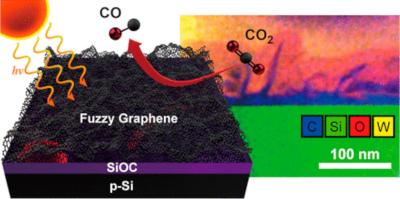Researchers from the University of North Carolina at Chapel Hill, Carnegie Mellon University, North Carolina State University and Yale University have developed a novel method to enhance the efficiency and stability of solar-driven, carbon-dioxide reduction.
Image credit: Applied Materials and Interfaces
This new technique involves the use of “fuzzy” graphene to improve the performance of semiconductor-based photoelectrodes, which initialize electrochemical transformations following the absorption of light. The term fuzzy refers to a form of graphene that has a rough or irregular surface with a porous and three-dimensional (3D) structure, as opposed to smooth or flat layers, with enhanced properties like surface area, reactivity or adhesion to a silicon molecule, or substrate.
“This innovative approach to integrate fuzzy graphene on planar semiconducting substrates represents a significant advancement in the field of photoelectrochemical CO2 reduction,” said Oluwaseun Oyetade, lead author of the paper and a postdoctoral research associate at UNC-Chapel Hill. “By overcoming previous limitations related to the stability and optical properties of silicon-carbon electrodes, we have paved the way for more efficient and durable solar-driven systems.”
In efforts to convert carbon dioxide into useful products, like fuels, scientists have been exploring ways to harness solar energy. Recent methods involve using semiconducting materials that absorb sunlight to drive the necessary chemical reactions. However, integrating stable and efficient carbon-based materials with these semiconductors has been a significant challenge. One major hurdle is creating a durable interface between the semiconductor and the carbon material. In addition, carbon materials often absorb too much light, which limits their effectiveness in these systems.
To solve these problems, the research team used a method called plasma-enhanced chemical vapor deposition (PECVD) to coat silicon wafers with a layer of fuzzy graphene. A silicon oxycarbide interfacial layer forms between the silicon and the graphene, creating strong bonds that keep the structure stable. The fuzzy 3D structure of the graphene on the flat silicon surface helps attract and hold molecules that act as catalysts, which are needed for chemical reactions to reduce carbon dioxide.
When light passes through a material, some of it is absorbed. This absorption can vary based on the material’s thickness. In this study, researchers measured the absorbance of a specific type of film at a wavelength of 400 nanometers and found that the optical transparency of the silicon-carbon photoelectrode is reduced with increased thickness.
The silicon in the electrode absorbs sunlight and generates electrical charges. The negative charge is then transferred to the fuzzy graphene layer, which supports a molecular catalyst cobalt phthalocyanine that is crucial for converting carbon dioxide into carbon monoxide. The key to the success of these photoelectrodes is the formation of a strong bond between the silicon and the graphene, resulting in a stable and durable electrode.
“The newly developed photoelectrodes demonstrated impressive performance in reducing CO2 under simulated sunlight,” said James F. Cahoon, a co-author of the paper. “This means that a significant portion of the electric current was effectively used to convert carbon dioxide into carbon monoxide and the system maintained stable performance for at least 30 hours, highlighting its potential for long-term use.”
Solar-driven carbon dioxide reduction mimics natural photosynthesis, where plants convert carbon dioxide and water into glucose and oxygen using sunlight.
“The benefits of solar-driven, carbon dioxide reduction include using abundant solar energy in the process,” said Tzahi Cohen-Karni, a co-author of the paper, “reducing atmospheric CO2 levels by converting it into useful products and creating fuels that can be used in place of fossil fuels, potentially reducing reliance on non-renewable energy sources.”


